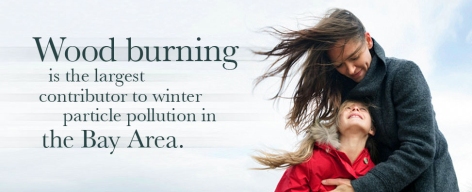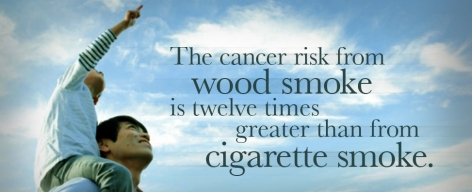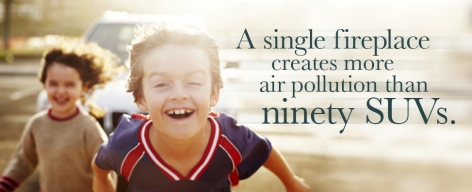If wood is burned properly, the only products that will be formed are a gas called carbon dioxide, some water which comes off as steam and a small amount of ash, which cannot burn. However, often the wood does not burn completely and it can make a lot of smoke with hundreds of different chemicals, called “products of incomplete combustion”.
Types of Air Pollutants
We can put these many different chemicals into groups of similarity called classes. Scientists know that some of these chemicals can cause problems for people, like causing disease in their lungs or heart, or making their illness worse if they are already sick.
However, there are a number of chemicals Scientists still hardly know anything about their affect on human health and research is being done to try and find out. Some of the chemicals are gases, some are liquids and others are solids. When there is more of a chemical mixed into the air than is good for us, we call it a pollutant.
What is Concentration?
Concentration is the word we use to describe how much of a pollutant is mixed with the air. There are two main ways, called “units”, that we use to describe concentration.
For particles, we use “micrograms per cubic metre”, written as “1 µg/ m3”. If you read further down, you will see a description of particles, or particulate matter.
- If you imagine a large cardboard box that is one metre high, one metre wide and one metre deep, it will contain one cubic metre of air. It is written as “m3”. This is called the “volume” of air.
- One microgram is one millionth of a gram. This is very tiny amount, but still large enough for us to measure. We shorten this to “1 µg”, where the Greek letter “µ” means “millionths of”, and “g” means “gram”.
- So a concentration of one microgram of smoke per cubic metre means that there is one millionth of a gram of smoke in each cubic metre of air, and we write it as “1 µg/ m3”.
For gases, we use another unit, called “parts-per-million”, written as “ppm”. This is a little harder to explain. There are several gases described lower down on this page. For example, carbon monoxide is a gas that often occurs in air.
- Imagine the same large cardboard box that you did before, containing a volume of one cubic metre of air.
- If we take a tiny box that has a volume of one cubic centimetre of carbon monoxide and add it to the air in our box, we make a concentration of 1 part-per-million of carbon monoxide in air, which is shortened to “1 ppm”.
Chemicals from Wood Burning
Some types of chemicals that come from burning wood are:
Carbon Dioxide (CO2)
Carbon dioxide is a gas that we cannot see or smell. It is given off whenever anything that contains carbon in its chemical structure is burned completely, along with water.
It is not dangerous to us in open air but it can asphyxiate us if there is too much of it in a small space. In other words, it prevents us from getting enough oxygen from the air to keep us alive. It is also what we call a greenhouse gas, which may be causing the earth to warm up.
Carbon Monoxide (CO)
Carbon monoxide is a gas that we cannot see, smell or taste. At very high concentrations, it is very poisonous, because it makes it very difficult for our blood to take oxygen from our lungs around to all the different parts of our bodies.
However, luckily it is very unusual to get much carbon monoxide in the outside air, except where there are many cars and trucks on busy roads, especially if they are stuck in a traffic jam. Even then, people need to be exposed for some time at the kinds of levels found in city streets, because it takes time for carbon monoxide to build up in our bloodstream.
So at lower concentrations in air, carbon monoxide can affect people with heart disease, because it makes their heart work harder to transport oxygen around their bodies. It has an Air Quality Standard of 9 ppm over 8 hours.
Nitrogen Oxides (NOx)
Nitrogen oxides can be made by fire, either because the fuels used contain chemicals with nitrogen in them, or because the fire is so hot that a small amount of nitrogen from the air combines with oxygen to form them. For example, a gas flame will often make nitrogen oxides because it is very hot.
Nitrogen oxides are also made by burning fuels like petrol and diesel in the engines of cars and trucks. There are two main types made by burning: nitric oxide (NO) and nitrogen dioxide (NO2), although there are some others that may be made in smaller amounts.
Nitrogen dioxide may also come from some industrial factories that make a powerful acid called nitric acid, factories that galvanise steel (coat it with zinc) and others that make glass or power stations that generate electricity.
Nitrogen dioxide has more effects on our health than nitric oxide. It can irritate our lungs and cause bronchitis and other lung diseases. Over a long time, it can cause scarring of the very delicate air spaces in our lungs and reduce the amount of oxygen that they can absorb into the blood. Because of its health effects, there is an air quality standard of 0.16 ppm for an hour.
Particulate Matter
When we speak of air pollution, particles are simply small materials that can be suspended or will float in the air. Particles can be quite large, like sand, or may be too small for us to see without a microscope. A large collection of particles is called particulate material or sometimes just particulates.
Most of the particles that we find in our cities are small and very complicated mixtures of many different things. They include:
- Dust blown by the wind from soil, or stockpiles of building materials, or industrial raw materials and products, or sometime just from the trucks that drive over dusty roads;
- Smoke from burning wood, oil, waste materials, or even gas;
- Pollen grains, bacteria, fungal spores, dust from wheat, barley and other cereals, tiny pieces of skin from animals;
- Dusts and fumes from chemical processes, welding, painting, gritblast cleaning and other industrial processes.
- Fog, mist and “smog”, which are really tiny droplets of liquid and sometimes solid particles, formed by natural processes in the atmosphere – sometimes called aerosols.
More information is available on Particulate Matter.
Volatile Organic Compounds (VOCs)
This is a very large group of chemicals that contains many hundreds of chemicals of many different classes. However, they are all chemicals that contain carbon. The word Volatile in their name simply means that they evaporate easily, like water does when it dries in the sun.
Some may contain carbon and hydrogen only. Others may have carbon, hydrogen and oxygen, while some may also have other elements like sulphur or nitrogen in their molecules. Because there are so many different types, the effects of every one of them on our health may be different and are not always understood.
Also, many of these chemicals help form a type of pollution called photochemical smog, in which ozone is formed, and is found in some large cities, such as Sydney and Melbourne. We do not believe that this type of smog pollution is a problem in Tasmania.
Aldehydes
There are many different types of aldehydes, many of which are poisonous or can irritate our eyes, nose and lungs, or are just plain smelly. Two such aldehydes are acrolein and formaldehyde. They may be in the air as gases, or mixed with particulate material.
Acrolein irritates our eyes, nose and our lungs, and is a special problem for some people who have asthma or bronchitis. It is often a product of burning wood but acrolein can also be made when fat burns, as happens on a charcoal barbecue when fat from the chops and sausages drips on to the hot beads.
Formaldehyde also irritates our eyes, nose and lungs and may cause cancer in some people. It comes from burning materials containing carbon but is also commonly used to make some types of special glues for making boats and in making particle boards for floors and walls.
Therefore, it may be found in the air near factories that make such products. It is also used for making several types of plastics, such as “Bakelite” and laminates that are used on kitchen tables and benches.
Formaldehyde can also come from gas stoves, or kerosene/oil/gas space heaters which do not have flues going outside the house. In many cases, formaldehyde concentrations may be much higher inside a house than outside. Some people can become very sensitive to formaldehyde so that very tiny amounts can make them sick.
Benzene, Toluene and Xylenes (BTX)
Benzene, toluene and xylenes are chemicals that are also called aromatic compounds, because they have a strong smell. They are often found in car exhaust gases, from cars or trucks burning petrol or diesel fuels but may also be made when other carbon-containing materials like wood or oil are not burned properly.
They all cause irritation to our eyes and nose and sometimes our lungs. At the levels usually found in ambient air, they are also known to have long-term effects on people’s nervous systems.
BTX are included in the new Air Toxic NEPM made in 2004. (See the Environment Protection and Heritage Council web site for details: National Environment Protection Measure on Air Toxics
Benzene is probably the worst of them, because it is very poisonous, affecting people’s livers and nervous systems. It probably also causes cancer. For these reasons, it has been removed from petrol, so it is much less of a problem than it was a few years ago. However, it is still made in car engines and comes out in the exhaust gases.
Toluene is not so poisonous as benzene, but is still a pollutant that comes from car exhausts. It is also found in smoke from fires and some other processes.
Xylenes (there are three of them) are often found in special paint thinners and brush-cleaning solvents or paint strippers. They are also made in car engines and wood fires. They are very irritating to our eyes, nose and lungs.
Polynuclear Aromatic Hydrocarbons (PAH)
Polynuclear aromatic hydrocarbons are a group of chemicals that are usually formed when materials containing carbon are burned very badly. We find them in black smoke, soot and tar from burning coal, wood, heavy oil, and other things like plastic, if there has not been enough air to burn them properly.
They can also be formed when we burn our toast at breakfast. They are quite complicated chemicals that do not evaporate easily, so they are often found sticking to particles of carbon. If the particles are small enough, they will get right down into the deepest parts of the lungs and may cause disease, including cancer.
We have known for a long time that one of them, called benzo(a)pyrene, can cause cancer. In the old days, chimneysweeps sometimes developed cancer due to benzo(a)pyrene in the soot that covered them every day as they worked. Benzo(a)pyrene is also included in the new Air Toxics NEPM.




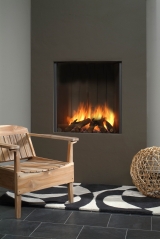



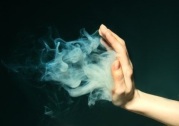


 If you are healthy, you’re usually not at a major risk from smoke. Still, it’s a good idea to avoid breathing smoke if you can help it.
If you are healthy, you’re usually not at a major risk from smoke. Still, it’s a good idea to avoid breathing smoke if you can help it.


